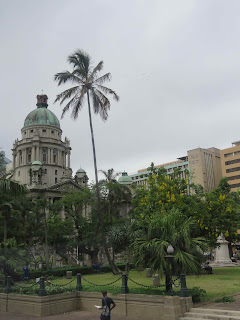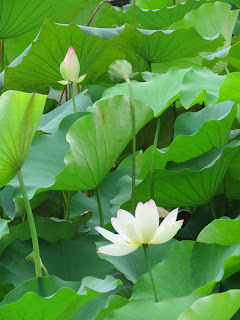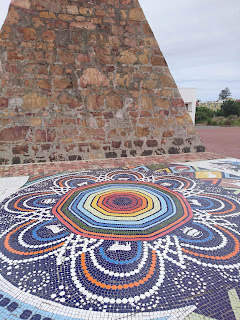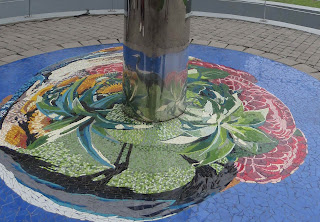Our first visit to South Africa began with a stop in
Richards Bay on the east coast. We would have another two stops before arriving
in Cape Town, and reaching the end of the cruise.
Richards Bay is not really a tourist destination, but more
still a mining and industry town. That seemed odd to us, given that the
waterfront around the working harbour is all part of a nature conservancy, but
there was enough fish, birds and other wildlife to suggest that all of the
companies there are being responsible in their activities.
Our excursion from Richards Bay was to the Hluhluwe-Umfolozi
Game Reserve about an hour away from the town. Over the past few days, we had
lost a good number of fellow cruise guests to overland safari trips ranging
from one night to four nights in length. We had decided not to take any of
these, since we figured there was very little chance that any of these could
compete with the experiences we had in 2013 on our Tauck safari, but we did
decide to do a day trip to one of the reserves to see what it was about.
 |
| No that's not an optical illusion - in the distance are the some of the highest vegetated sand dunes in the world, as opposed to the ones in the desert where nothing grows. |
 |
| Donkeys outside of a 'beehive hut', the traditional homes of some of the earliest migrants to this part of Africa from the north. |
The reserve we visited is huge, about 960 square kilometres
of wild bush. All of the big game is in the reserve, it would just be a matter
of finding it. We weren't sure of just how many animals we would see, given
that we arrived there at 11:30 a.m. and only had a two-hour game drive ahead of
us, but we set off with 7 other guests in our open safari truck to see what we
could find.
All in all not so bad a day, but nothing like our previous
safari experience.
The next day we were in the city of Durban, supposedly 'the'
resort area of South Africa. From what we saw, the resorts must be a good way
outside of town, because the city centre certainly did not look like a place
where tourists would want to hang out.
 |
| A market stall selling all kinds of masala, or spice mixes. They even have one called 'Mother-in-law Exterminator'! |
 |
| Some of the beadwork items for sale. |
Our tour guide told us about Durban's history and the way
that the European explorers took advantage of and even killed many of the
indigenous people in their quest to claim the new lands for their own
countries. That is probably what started the animosity between white and black
in the sixteenth and seventeenth centuries. It seemed to have died down as the
settlers and the locals began to work together, but it wasn't until the 1950s
when the South African government imposed 'apartheid', or dividing the people
by race and colour, deciding where they could live and what they could do, that
everything blew up again. The abolition of apartheid in the 1990s has now only
served to undermine the economy for everyone. According to our guide, the vast
majority of young people, white, black or coloured, will never be able to find
a job, and many who can possibly afford it are leaving South Africa entirely to
try to make it elsewhere.
 |
| A lovely example of art deco near the waterfront |
 |
| The city hall |
 |
| Staghorn fern growing on a tree |
 |
| Lotus flowers in the pond |
 |
| This gorgeous little bird is a Southern Red Bishop |
 |
| The orchid display |
 |
| The famous Encephalartos Woodii, the mother of all the world's cycads |
 |
| A Strelizia Reginae, or Bird of Paradise flower |
We continued with our city tour, stopping at an overlook to see a very interesting sports combination - the local horse racetrack, which is quite long, encircles the city golf course, which must be shorter than 18 holes. That certainly was unexpected!
 |
| Looking over the green space that is the golf course. If you look closely around the edges you will see the racetrack. |
 |
| One of the popular pastimes here on the south coast is surfing, and with those waves it isn't surprising. |
After our return to the ship we talked to others who visited
the "boardwalk" area, which is where the resorts are, but no one
seemed to be overly impressed by what they had seen. Overall a rather
disappointing day.
That night we ate at Umi Uma again and had a few different
things from previous visits:
 |
| Tuna tataki and little lobster tacos |
 |
| Rock shrimp and vegetable tempura |
 |
| A selection of sashimi along with dragon roll |
And the following day we had the Apropos Joseph Ribkoff
fashion show. The Ribkoff ambassador had come on board in Mauritius and brought
a selection of the new collection along, so we had the chance to model for our
fellow guests.
 |
| Modeling palazzo pants and a black asymmetrical top |
And right after that, the World Cruise Gala Buffet took
place. This time we just looked around, took some photos, and ate at the
Marketplace buffet upstairs.
And the next day we arrived in Port Elizabeth, our last port
before Cape Town. Here we took a walking tour around the old part of town. Our
guide, Tracy, used to be a schoolteacher, and had a great way of injecting
funny anecdotes into the historical information she was giving us.
 |
| A mural by the waterfront depicting the history of people in the area of Port Elizabeth |
 |
| A few of the Mandela quotations |
A very impressive site was the Donkin Reserve. Sir Rufane Donkin was in charge of the first settlement here, and he named it after his wife, Elizabeth. When she died, he built the pyramid up on this hill as a memorial. The mosaic work around this park is quite lovely, especially the walk on top.
 |
| Representing some of the animal life in the area |
 |
| The beautiful design at the base of the pyramid |
We had a short rest stop at the Grand Hotel, which has been
restored to reflect its glory days. Monica said it was the kind of place where
you'd expect to see Agatha Christie's Hercule Poirot wander into the
parlour....
 |
| And they even had an original one-armed bandit standing in the corner! |
Our walking tour ended at Fort Frederick, where we had a great overlook on the working port and the bay. On the bus back to the port, we had a chance to see another art installation close up - the taxis that could drive right into concrete walls.
Port Elizabeth was our last stop before Cape Town and the
end of our 37 days on Crystal Serenity, but we would have the best tour guides
to take us around Cape Town once we got there. We were looking forward to
seeing Juergen and finally meeting Maria, but we still had to finish the 'P'
word - packing!




























No comments:
Post a Comment